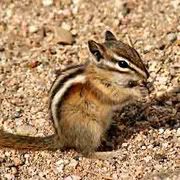

Forbidden Love:
Tamias ruficaudus and Tamias amoenus
This Blue Monday I had the pleasure of interviewing my former lab TA, Masters student Sarah Hird. Sarah is working in Jack Sullivan’s lab, investigating a cute-n-cuddly (although admittedly sometimes rabies ridden) Idaho favorite: chipmunks. She is mainly examining two species; red tailed (Tamias ruficaudus) and yellow pine (Tamias amoenus) chipmunks as well as their four subspecies that appear in overlapping species boundaries in Idaho and Montana.
Traditionally, species were thought to be discrete with no possible interbreeding. It appears though, in the case of these chipmunks, that species lines have been burred. These “loose chipmunks” show genetic markers that do not line up with the traditional measure of speciation in chipmunks: the penis bone. The penis bone may sound like an odd morphological difference to look for, but primates are actually a rare variety of mammal in that we do not have penis bones. Like most mammals, chipmunks do and they differ in shape and size from species to species.
Sarah is working with new methods of phylogenetic analysis (the estimation of evolutionary trees) to identify the relatedness of these species and subspecies. Primarily, she is utilizing analysis of microsatellite DNA. Microsatellites are sequences of tandem repeating base pairs that are non-functional, and therefore can show more variation between individuals and help determine relatedness. Microsatellites are also commonly used in forensics, to figure out “who done it.” She is looking into mitochondrial DNA as well, which can be an indicator of maternal inheritance. These techniques are important not only to solving the chipmunk mystery, but also help pioneer new techniques for developing phylogenetic trees.
On the Sullivan lab web sit, they write that phylogenetic analysis "has become the cornerstone of evolutionary biology," as it is a more precise method of measuring relatedness, available right in the genetic code.
So will these novel techniques have poor Linnaeus spinning in his grave? Probably not, as biology is a science as changing and adapting as the organisms it seeks to understand. The old Linnaean classification system was the best they could do at the time, but with new technology and the blooming science of genomics we can have a better understanding of organism classification, their evolutionary development, and their relationship to each other.

The Drink!: Sarah is enjoying a Bloody Marry which consists of 2 shots vodka in tomato juice, 3 drops Tabasco, 1/2tsp Worcestershire, pepper, lime slices and green olives or celery sticks.
Sources: http://www.webpages.uidaho.edu/~jacks/projects.html
Images: http://ourworld.cs.com/juddphotopage/rmnp/wildlife.htm
http://www.enature.com/fieldguides/


0 Comments:
Post a Comment
<< Home